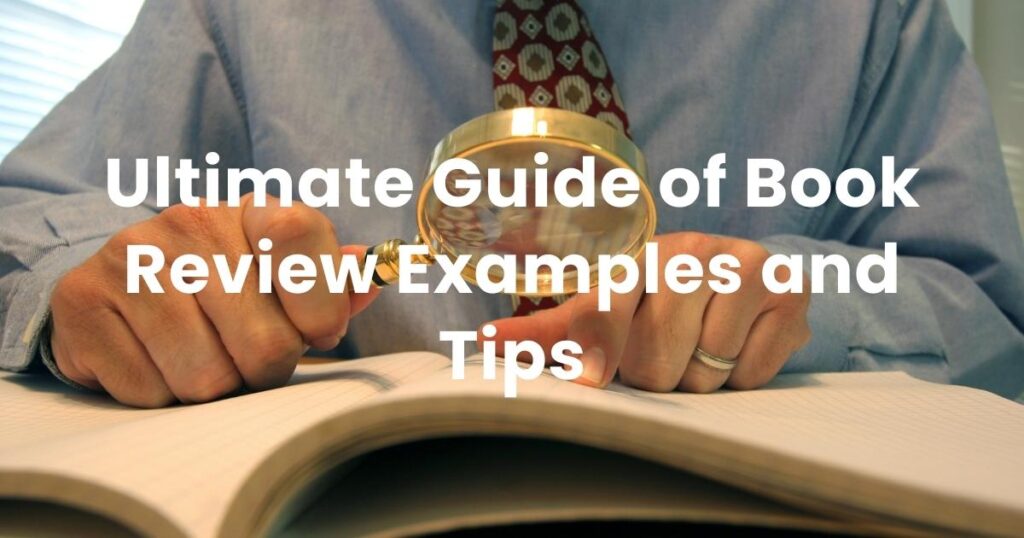Book reviews serve as invaluable guides for readers looking to discover their next great read. An effective review not only summarizes the plot but also shares insights, critiques, and personal impressions that can resonate with potential readers. In this blog, we’ll explore various book review examples and provide tips to help you write your own engaging reviews.

What is A Book Review?
A book review is an objective and comprehensive evaluation of a particular book. It assesses the book’s content, style, and relevance to the field it covers. Written by scholars, experts, or avid readers, book reviews provide potential readers with an insight into the quality, content, and significance of a given book. They are usually written in newspapers, magazines, online platforms, and academic journals.
Book reviews can be used as a valuable resource for readers who want to make an informed decision when choosing what to read. For college students especially, reading reviews can help them gain insight into books that may be interesting and helpful for their studies.
Types of Book Reviews
Summary Review
A summary review provides a concise overview of the book’s plot, characters, and themes without revealing spoilers. This type of review is particularly useful for readers who want a quick understanding of the book’s content.
Summary Book Review Examples:
“In ‘The Night Circus’ by Erin Morgenstern, we are introduced to a mysterious competition between two young illusionists, Celia and Marco. Set in a magical circus that only opens at night, the narrative weaves through multiple timelines and intertwining lives as the stakes of their rivalry escalate. The lush and atmospheric writing immerses readers in a world rich with magic and wonder, inviting them to explore themes of love and sacrifice. Morgenstern’s intricate storytelling and vivid descriptions create a visual feast that captivates the imagination.”
For a successful summary review, start by identifying the main premise of the book. Don’t just recount the plot chronologically; instead, highlight key moments that set the tone or establish the central conflicts. Aim to evoke curiosity without divulging major twists or the ending, as this will keep readers intrigued and encourage them to explore the book themselves.
Analytical Review
An analytical review dives deeper into the components of the book, examining aspects like character development, themes, and writing style. This is ideal for readers who appreciate a thorough exploration of the work.
Analytical Book Review Examples:
“‘Pride and Prejudice’ by Jane Austen not only offers a captivating love story between Elizabeth Bennet and Mr. Darcy but also serves as a sharp critique of social class and gender roles in the 19th century. Austen’s artful use of irony and wicked humor allows her to explore the rigid social hierarchies of her time, positioning Elizabeth as a forward-thinking protagonist who challenges societal norms. The development of Darcy’s character—from aloof and proud to humble and understanding—mirrors Elizabeth’s own growth, making their eventual union feel earned and genuine. Austen’s mastery of dialogue enriches the narrative, offering comments on love, marriage, and the value of personal integrity.”
In an analytical review, focus on breaking down the elements that contribute to the book’s overall impact. Discuss character arcs, thematic depth, writing style, and how effectively the author conveyed their messages. Use specific examples from the text to support your critiques. This approach not only highlights the book’s strengths and weaknesses but also encourages readers to engage with it on a deeper level.
Personal Reflection Review
A personal reflection review emphasizes the reviewer’s unique experience with the book, relating it to their own life, beliefs, and feelings. This type of review can create a strong emotional connection with readers.
Personal Reflection Book Review Examples:
“Reading ‘Educated’ by Tara Westover felt like a journey through my own educational struggles. Westover’s gripping memoir of growing up in a strict and isolated household in rural Idaho resonated deeply with me, magnifying the transformative power of education. Her resolute determination to pursue knowledge despite familial opposition and the challenges of the traditional schooling system inspired me and reminded me of the privilege we often take for granted. ‘Educated’ transcends mere storytelling—it is a powerful testament to resilience, identity, and the courage it takes to break free from one’s past. This memoir encouraged me to reflect on my educational journey and the societal structures surrounding it, making it a must-read for anyone who values the quest for knowledge.”
For a personal reflection review, allow your voice and emotions to shine through. Share specific instances from the book that triggered memories or feelings in your own life, which can make your review relatable and poignant. While it’s important to share your personal views, strive to connect those personal experiences back to the text itself, reinforcing the book’s significance in your life. This can prompt readers to consider how the themes may resonate with their own experiences, making your review impactful.
Comparative Review
A comparative review contrasts a book with other works, providing context and highlighting similarities or differences. This approach can help readers understand the book’s place within a larger literary landscape.
Comparative Book Review Examples:
“While both ‘The Great Gatsby’ by F. Scott Fitzgerald and ‘The Catcher in the Rye’ by J.D. Salinger explore themes of disillusionment and the quest for identity, they do so from markedly different angles. Gatsby’s tragic pursuit of the American Dream reflects an era of excess and superficiality, while Holden Caulfield’s aimless wandering speaks to generational angst in a post-war society. Fitzgerald’s lush, poetic prose evokes a sense of glamour and nostalgia, immersing readers in the opulence of the Jazz Age, whereas Salinger’s raw, colloquial language draws you into Holden’s internal struggle. Together, these works offer complementary perspectives on the challenges of finding meaningful connections in a world that often feels hollow.”
In a comparative review, choose books that have thematic or stylistic parallels or contrasts. Craft your analysis by exploring similarities or differences in characters, settings, and authorial intent. This type of analysis not only provides deeper insight into each work but also helps readers appreciate the nuances between them. Additionally, consider using broader literary context—like historical or cultural influences—to enrich your comparisons and give readers a holistic view of the subject matter.
Tips for Writing Your Own Book Review
Know Your Audience:
Tailor your writing style and content to the readership of the platform where your review will appear. Are they casual readers, academic audiences, or genre enthusiasts? Understanding your audience will help you choose the right tone, language, and focus for your review.
If you’re writing for a younger audience, consider a more conversational tone, while a literary magazine might require a more formal and analytical approach. Think about the interests and expectations of your audience, and craft your review to meet those specific needs.
Be Honest, But Respectful:
Even if you didn’t enjoy a book, provide constructive criticism rather than harsh judgments. Highlight aspects that worked or didn’t, and why. It’s essential to express your opinions sincerely, yet with consideration for the author’s effort.
Rather than simply stating that a book was “boring,” consider discussing pacing or character motivation and how those elements detracted from your enjoyment. A balanced critique that acknowledges both strengths and weaknesses can foster a sense of trust with your readership.
Engage the Reader:
Start with a hook—a striking quote, an intriguing question, or a bold statement that encourages readers to keep going. A compelling opening can set the tone and spark curiosity, drawing readers into the rest of your review.
For example, you might open with a thought-provoking question: “What price are we willing to pay for our dreams?” This could relate to the themes explored in the book and encourage readers to consider their own beliefs as they engage with your review.
Use Quotes:
Incorporate quotes from the book to support your points and enhance the authenticity of your review. Quotations can illustrate your arguments and provide examples of the author’s style or themes.
Choose quotes that highlight key moments, powerful dialogues, or thematic elements. When using quotes, explain their relevance and how they enhance your understanding or critique of the book. This not only gives depth but also demonstrates your engagement with the text.
Stay Focused:
Keep your review concentrated on key elements. Avoid digressions unless they serve to strengthen your main arguments. Every sentence should aim to support your overall perspective and keep the reader engaged.
Consider creating a bulleted list of main points before writing your review. This helps to organize your thoughts and ensures that you cover all relevant elements without straying from your primary focus.
Include a Recommendation:
Conclude with your thoughts on who might enjoy the book and why. This helps readers decide whether to add it to their reading list.
You could say something like, “This book is perfect for fans of magical realism and those who appreciate richly woven narratives with complex characters.” Tailor your recommendations to different demographics—like fans of a particular genre, age group, or those looking for thematic explorations.
How to Write A Book Review? Arvin is Your Perfect Assistant!
Writing a book review can seem daunting, but with Arvin by your side and with these book review examples, you’ll find the process easier and more enjoyable. Here’s how Arvin can assist you every step of the way:
1. Understanding the Book
- Summary Assistance: Arvin can help you summarize the book’s main plot, themes, and characters, allowing you to present a clear overview in your review.
- Contextual Insights: Arvin can provide background information about the author, the book’s historical context, and its place within the genre.
2. Structuring Your Review
- Template Creation: Arvin can offer you a structured template to follow, including sections like introduction, summary, analysis, personal reflection, and conclusion.
- Outlining: Together, Arvin can create an outline and topic sentences that organizes your thoughts and points of discussion logically.
3. Deep Analysis
- Character Analysis: Arvin can help you delve into character development, motivations, and relationships, which can enrich your analysis.
- Theme Exploration: Arvin can assist in identifying key themes in the book suggest ways to discuss their relevance and impact and provide the statement of the theme.
4. Enhancing Your Writing
- Variety in Sentence Structure: Arvin can provide tips on varying your sentence length and structure to keep the reader engaged. Mixing, impactful sentences with longer, more complex ones can create a dynamic reading experience.
- Vivid Descriptions: Arvin can assist in crafting descriptive language that brings your thoughts to life. This might involve helping you find metaphors, similes, and sensory details that evoke emotion. For instance, instead of saying “the characters were sad,” you could say, “the characters carried the weight of their grief like stones in their pockets.”
Conclusion
Writing a compelling book review is an art that can help others navigate the vast literary landscape. By drawing on the book review examples provided and implementing the tips discussed, you can craft reviews that are not only informative but also resonate on a personal level with your audience.
FAQs
Book Review of The Night Circus by Erin Morgenstern
The Night Circus mesmerizes with its enchanting tale of magic and competition. Set in a mysterious circus that opens only at night, the story revolves around illusionists Celia and Marco, bound in a fierce rivalry. Morgenstern’s lush prose creates a vivid atmosphere, exploring themes of choice, fate, and love. The nonlinear narrative captivates, making it a beautifully intricate read. I highly recommend this novel to anyone seeking immersive storytelling and exquisite imagery. A truly unforgettable experience!
You should include a very brief overview of the contents of the book, the purpose or audience for the book, and your reaction and evaluation. Reviews then generally move into a section of background information that helps place the book in context and discusses criteria for judging the book.
If you are wondering how to start an article review, begin with an introduction that mentions the article and your thesis for the review. Follow up with a summary of the main points of the article. Highlight the positive aspects and facts presented in the publication.






